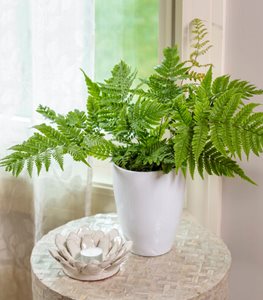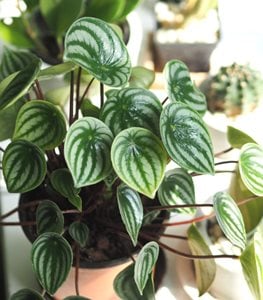Bathroom Plants: Houseplants That Thrive in Humidity
12 beautiful houseplants that thrive in warm, humid rooms Published 9/9/2022The warm, steamy environment of a bathroom is ideal for growing many tropical houseplants that would struggle in a drier atmosphere. These aren’t always the easiest houseplants to grow because they can be sensitive to drafts and temperature fluctuations, but they are among the most eye-catching. Some feature beautifully variegated foliage and others will produce gorgeous flowers. As long as you give them the moisture and greenhouse-like conditions they crave, they will flourish with little additional pampering.
On this page: Bathroom Plants | Care Tips
On this page:
PLANTS FOR BATHROOMS
ALOCASIA (Alocasia hybrids)
Size: 2 to 6 feet tall and wide, depending on variety
Light: Place in a location that receives bright, indirect light, such as near an east- or west-facing window. Keep out of direct sunlight, which can scorch the foliage.
Water: Water regularly during the growing season (spring through fall) to keep the soil evenly moist, but not soggy; less frequently during winter.
Fertilize: Feed with a diluted liquid houseplant fertilizer one to two times per month during spring and summer.
Although some alocasias can grow as tall as 6 feet, you can also find compact forms, sometimes called “jewel alocasias,” that are small enough to display on a bathroom countertop. These tropical beauties flourish in greenhouse-like conditions, so keep them away from cold drafts and don’t expose plants to temperatures below 60° F. Learn more about growing Alocasia.
BIRD'S NEST FERN (Asplenium spp.)
Size: Up to 3 to 5 feet tall, 2 to 3 feet wide
Light: Prefers indirect, filtered light, such as from a north-facing window. Keep away from harsh sunlight, which can burn the fronds.
Water: Keep the potting mix evenly moist. Water as soon as the surface of the potting mix feels mostly dry.
Fertilize: Feed once a month at half strength when plant is actively growing.
Many ferns, such as bird’s nest fern and blue star fern, relish the extra moisture found in a bathroom. The added humidity will help keep the leaf edges from browning, as long as you water your plants consistently and keep them away from cold drafts. Learn more about different types of ferns.
AUTOGRAPH TREE (Clusia rosea)
Size: Rarely taller than 3 to 4 feet indoors
Light: Prefers medium to bright indirect light, such as from an east- or west-facing window. Avoid direct sunlight, which can scorch the leaves.
Water: Keep soil lightly moist, not soggy.
Fertilize: Feed once a month with a water-soluble plant fertilizer diluted to half strength in the growing season; withhold fertilizer in winter.
True to its name, autograph tree’s most unique feature is its ability to be personalized by carving your name or initials into one of its thick, leathery leaves. This plant thrives in high humidity and room temperatures between 60° to 85° F. In drier areas of the home, keep your plant hydrated by using a humidifier or misting the leaves regularly. Learn more about how to grow autograph tree plants.
See more on Tattoo™ Princess autograph tree from Proven Winners
NEVER NEVER PLANT (Ctenanthe spp.)
Size: 12 to 36 inches tall
Light: Place in the medium indirect light of a north- or east-facing window; the foliage is sensitive to bright sunlight.
Water: Keep soil moist, but not soggy. Use distilled or filtered water, as plants are sensitive to impurities and salts in tap water.
Fertilize: Feed once a month with a water-soluble plant fertilizer diluted to half strength in the growing season; withhold fertilizer in winter.
Ctenanthe is the perfect bathroom plant because it grows well in the low-light conditions typical of many bathrooms. Leaf damage is possible when humidity levels drop below 40%, so avoid placing your plant in drier areas of the home or near heating and cooling vents. Learn more about how to grow never never plants.
Proven Winners® leafjoy® SpaScene® Collection
Humidity-loving plants for bathrooms.
Warm air filled with humidity keeps the leaves of these plants looking healthy. The spa-like atmosphere of bathrooms, sunporches, or even the windowsill over your kitchen sink are all ideal locations.
See the enitre SpaScene® Collection of humidity-loving houseplants.
AUTUMN FERN (Dryopteris spp.)
Size: 24 to 36 inches tall
Light: Bright, filtered light is best. Avoid expose to direct sunlight.
Water: Keep potting mix evenly moist, watering as soon as the surface feels mostly dry.
Fertilize: Feed once a month with a water-soluble plant fertilizer diluted to half strength in the growing season; withhold fertilizer in winter.
Here’s another bathroom-friendly fern, unique for its beautifully colored fronds that emerge rich coppery orange, aging to a honey green, and finally deep green. Avoid exposure to cold drafts, which can cause browning of the leaf tips and edges. Learn more about different types of ferns.
POTHOS (Epipremnum aureum)
Size: Vines 6 to 10 feet long
Light: Bright indirect light is preferred, but plants will also tolerate low light. Leaves will lose some of their variegation if grown in too little light.
Water: Allow the top inch of soil to dry out between watering.
Fertilize: Light feeder; use a balanced liquid fertilizer every 1 to 3 months when plant is actively growing.
This popular tropical vine prefers a high-humidity environment similar to its native habitat, but will also tolerate average household humidity levels and a wide range of light exposures, from low light to bright indirect light. Can be grown in hanging baskets or even as a climber if you give it a support like a moss pole or other climbing structure. Learn more about how to grow pothos plants.
PHILODENDRON(Philodendron spp.)
Size: Vines to 8 feet long
Light: Tolerates low light, but will grow faster in medium to bright light.
Water: Prefers evenly moist soil, but not soggy. Water if top inch of soil is dry.
Fertilize: Apply a water-soluble houseplant fertilizer from spring through fall.
Philodendrons offer a variety of sizes and growth habits including vines and tall, treelike shrubs. Although heart-shaped leaves are the norm, you’ll also find varieties with spade-shaped, deeply cut, and spear-shaped leaves, some with beautifully variegated foliage. Like pothos, these tropical plants prefer a humid environment, but will also tolerate average home humidity levels. Learn more about how to grow philodendron plants.
ARROWHEAD VINE(Syngonium podophyllum)
Size: Trails or climbs up to 6 feet
Light: Prefers bright indirect light, such as in front of an east- or west-facing window.
Water: Prefers evenly moist soil, but not soggy. Water when top inch or two of soil is dry.
Fertilize: Apply a water-soluble houseplant fertilizer from spring through fall.
This versatile houseplant is an enthusiastic climber but can be pruned to keep it compact and bushy. An unusual feature is that the leaves change shape as they mature, starting out arrow-shaped and becoming lobed over time. For the best results, grow in a warm, humid environment protected from direct sunlight. Learn more about how to grow arrowhead vines.
TRADESCANTIA (Tradescantia spp.)
Size: 2 to 4 inches tall, trails to 3 feet
Light: Grow in bright indirect light. Insufficient light results in spindly plants that are not as full.
Water: Tradescantias prefer moist soil; avoid overwatering to prevent root rot.
Fertilize: Use a balanced liquid houseplant fertilizer monthly.
Also known as spiderwort, this easy-to-grow vine features colorful striped foliage and a trailing habit, making a pretty display when allowed to spill from a hanging pot or basket. It grows best in moderate to high humidities. If you see the leaf tips beginning to brown, it could be a sign that the humidity is too low. Learn more about how to grow tradescantia plants.
See more on Feeling Flirty™ purple tradescantia from Proven Winners
NERVE PLANT (Fittonia albivenis)
Size: 6 to 8 inches tall
Light: Low to moderate indirect light. Keep away from bright sunlight.
Water: Water when the soil surface begins to feel dry. Drooping leaves are another sign that your plant needs water.
Fertilize: Once a month, using a diluted liquid houseplant fertilizer.
Named for the intricate veins running through its foliage, this charming houseplant (also called mosaic plant) is ideal for brightening up small containers and terrariums. Although nerve plant grows well under a wide range of light conditions, this rainforest native needs adequate moisture and humidity to prevent the colorful leaves from becoming brown and withered. Learn more about how to grow nerve plants.
CHINESE EVERGREEN (Aglaonema spp.)
Size: 2 to 3 feet tall
Light: Low light (bright enough to read by) is sufficient. Never place in direct sunlight.
Water: Keep soil evenly moist, but not soggy. Brown leaves can result from underwatering, low humidity, or cold drafts.
Fertilize: Once a month in spring and summer. Avoid fertilizing in winter.
Here’s a plant you can grow almost anywhere because it adapts to a wide range of indoor growing conditions, including poor light. Most varieties have lush green leaves attractively patterned with silver, pink or red. When grown in brighter light, Chinese evergreens will also produce pretty, peace-lily-like blooms. Learn more about how to grow Chinese evergreen plants.
PEPEROMIA (Peperomia obtusifolia)
Size: 6 to 12 inches tall
Light: Will tolerate low light, but for the best leaf color, grow under bright indirect light, such as an east- or west-facing window. Can also be grown under fluorescent lighting.
Water: Every 7 to 10 days, or when the top inch or two of soil feels dry to the touch.
Fertilize: Apply a diluted liquid fertilizer once a month from early spring through late summer. Do not fertilize in winter.
Perhaps no houseplant offers a greater array of foliage colors, textures, and shapes than peperomia. Most varieties are also small in size, making them ideally suited for shelves, tabletops, and windowsills. Because peperomias are native to tropical regions, they prefer moderate to high humidity and thrive in places like terrariums and brightly lit bathrooms. Learn more about how to grow peperomia plants.
CARE TIPS FOR BATHROOM PLANTS
1. Give your plants a humidity boost. Many tropical houseplants prefer humidity levels above 40%, which is hard to maintain even in a bathroom, especially a powder room or guest bathroom that’s infrequently used. To increase the humidity around your plants, it helps to mist them occasionally or set their pots on a shallow tray or saucer filled with pebbles and water. Or try growing smaller plants, such as jewel alocasias and nerve plant, in a closed terrarium. (See these 10 DIY terrarium tips.)
2. Don’t substitute humidity for watering. These plants may get by on less frequent watering if grown in a humid room versus a dry one, but you can’t forgo it altogether. Check the moisture level of the soil often and water as needed.
3. Treat your plants to a shower. With the exception of plants that don’t like water on their foliage, such as rex begonia, most bathroom plants will benefit from the steam and moisture boost of a gentle shower using warm (not hot) water. An occasional shower will also help rinse dust accumulation off the leaves.
4. Consider lighting requirements. Many plants that thrive in high humidity also need plenty of bright light. Make sure your bathroom has a window or skylight before making it a home for your houseplants. Another option is to illuminate your bathroom with florescent lighting, which is often sufficient for plants that tolerate lower light levels.
5. No bathroom space? These plants will also be happy growing in a sunny kitchen, where they will benefit from the extra moisture in the air generated during cooking and dishwashing. Just avoid placing them too close to a heat source, like an oven or stovetop. A bright windowsill over a kitchen sink is ideal.




















